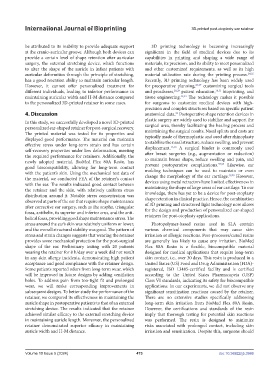Page 481 - IJB-10-5
P. 481
International Journal of Bioprinting 3D-printed post-otoplasty ear retainer
be attributed to its inability to provide adequate support 3D printing technology is becoming increasingly
at the cranio-auricular groove. Although both devices can significant in the field of medical devices due to its
provide a certain level of shape retention after auricular capabilities in printing and shaping a wide range of
surgery, the external stretching device, which functions materials, its precision, and its ability to meet personalized
to alter the shape of the auricle in infant patients with and other customized requirements, as well as its high
auricular deformities through the principle of stretching, material utilization rate during the printing process. 24,25
has a good retention ability to maintain auricular length. Recently, 3D printing technology has been widely used
However, it cannot offer personalized treatment for for preoperative planning, 26,27 customizing surgical tools
different individuals, leading to inferior performance in and prostheses, 28,29 patient education, 30,31 bioprinting, and
maintaining auricular width and H-M distance compared tissue engineering. 32,33 The technology makes it possible
to the personalized 3D-printed retainer in some cases. for surgeons to customize medical devices with high-
precision and complex structures based on specific patient
4. Discussion anatomical data. Postoperative shape retention devices in
34
In this study, we successfully developed a novel 3D-printed plastic surgery are widely used to stabilize and support the
personalized ear-shaped retainer for post-surgical recovery. surgical area, thereby facilitating the healing process and
The printed material was tested for its properties and maintaining the surgical results. Nasal splints and casts are
displayed good performance. The material can maintain typically made of thermoplastic and used after rhinoplasty
effective stress under long-term strain and has certain to stabilize the nasal structure, reduce swelling, and prevent
35,36
self-recovery properties under low deformation, meeting displacement. A surgical binder is commonly used
the required performance for retainers. Additionally, the after breast surgeries (e.g., augmentation or reduction)
newly adopted material, BioMed Flex 80A Resin, has to maintain breast shape, reduce swelling and pain, and
37,38
good biocompatibility, allowing for long-term contact prevent postoperative complications. Likewise, ear
with the patient’s skin. Using the mechanical test data of molding techniques can be used to maintain or even
39,40
the material, we conducted FEA of the retainer’s contact change the morphology of the ear cartilage. However,
with the ear. The results indicated good contact between devices using metal retractors have limited effectiveness in
the retainer and the skin, with relatively uniform stress maintaining the shape of large areas of ear cartilage. To our
distribution around it. Notable stress concentration was knowledge, there has yet to be a device for post-otoplasty
observed at parts of the ear that require shape maintenance shape retention in clinical practice. Hence, the combination
after corrective ear surgery, such as the scapha, triangular of 3D printing and structured light technology now allows
fossa, antihelix, its superior and inferior crus, and the anti- for the design and production of personalized ear-shaped
helical fossa, providing good shape maintenance stress. The retainers for post-otoplasty applications.
stress around the ear’s skin was relatively uniform or lower, Photopolymer-based resins used in SLA contain
and the overall structural stability was good. The pattern of various chemical components that may cause skin
stress and strain changes suggests that wearing the retainer irritation or allergic reactions. Post-processes/cured resins
provides some mechanical protection for the post-surgical are generally less likely to cause any irritation. BioMed
shape of the ear. Preliminary testing with 20 patients Flex 80A Resin is a flexible, biocompatible material
wearing the retainer for 8 h/day over a week did not result designed for medical applications that require long-term
in any skin allergy incidents, demonstrating high patient skin contact, i.e., over 30 days. This resin is produced in a
acceptance and good compliance with the retainer design. United States (US) Food and Drug Administration (FDA)-
Some patients reported odors from long-term wear, which registered, ISO 13485-certified facility and is certified
will be improved in future designs by adding ventilation according to the United States Pharmacopeia (USP)
holes. To address pain from too-tight fit and prolonged Class VI standards, indicating its safety for biocompatible
wear, we will make corresponding improvements in applications. In our experiments, we did not observe any
subsequent designs. To better study the performance of the significant sensitization reactions caused by the retainer.
retainer, we compared its effectiveness in maintaining the There are no extensive studies specifically addressing
auricle shape in postoperative patients to that of an external long-term skin irritation from BioMed Flex 80A Resin.
stretching device. The results indicated that the retainer However, the certifications and standards of the resin
achieved similar efficacy to the external stretching device imply that thorough testing for potential skin reactions
in maintaining auricle length. Moreover, the personalized was performed. The resin is designed to minimize
retainer demonstrated superior efficacy in maintaining risks associated with prolonged contact, including skin
auricle width and H-M distance. irritation and sensitization. Despite this, surgeons should
Volume 10 Issue 5 (2024) 473 doi: 10.36922/ijb.3986

